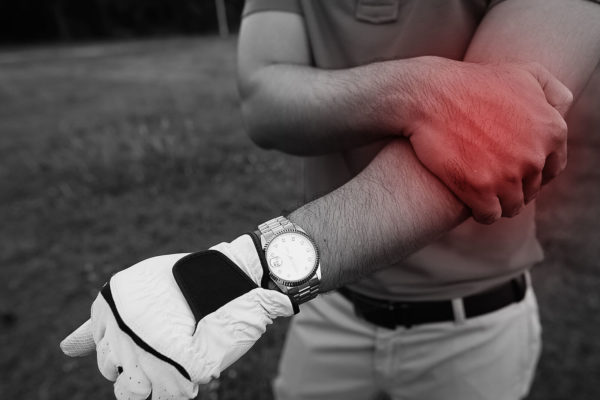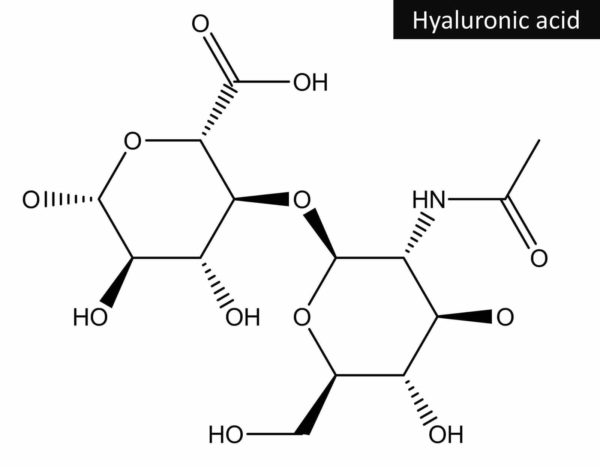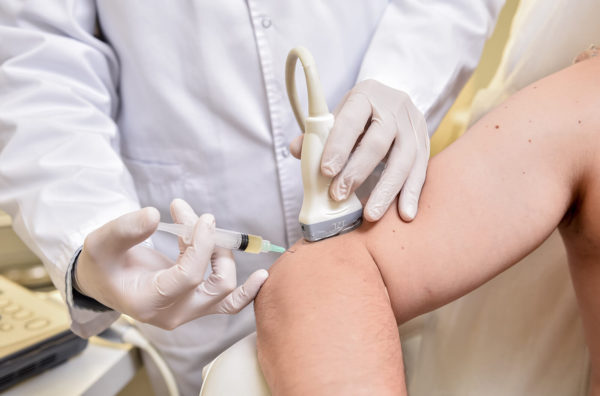Lateral epicondylitis or common extensor tendinopathy (commonly known as tennis elbow) is a very common condition causing pain on the outside of the elbow. NHS research suggests that tennis elbow affects between 1-3% of the population annually (nhs.uk, 2020).
It is certainly the most common complaint in people presenting with persistent elbow pain, accounting for two-thirds of cases. Women and men are equally affected, with a common age range of 35-54 years old.
The condition is thought of as an ‘over-use’ injury. It is prevalent in people that indulge in racquet sports (hence the name), but also in people that regularly lift weights or have manual or repetitive task occupations (such as painters, plasterers, and assembly line workers).
WHAT ARE THE SYMPTOMS OF TENNIS ELBOW?
- Pain, point tenderness and occasional inflammation (swelling) on or around the bone and muscles on the outside of the elbow.
- Pain is often worse when gripping (for example when lifting weights, furniture, kettles, pans and tools), carrying (for example shopping bags, children, suitcases), and/or twisting movements such as opening jars or turning door handles.
- Pain can be extreme with direct contact to the elbow e.g., knocking it on a wall or against a cupboard.
Tennis elbow can be an extremely frustrating, painful, and debilitating condition especially if it affects your ability to perform simple everyday tasks and play the sport you enjoy. The majority of tennis elbow cases can be managed well with specialist advice and a combination of physiotherapy and activity modification.
Please see our blog regarding the conservative management of tennis elbow, which discusses the anatomy of the condition and tips to manage your pain, as well as other treatments including Extracorporeal Shockwave Therapy (ESWT), ultrasound guided steroid injections, and platelet rich plasma (PRP) injections.

WHAT ARE HYALURONIC ACID INJECTIONS?
The use of hyaluronic acid (also known as hyaluronate, visco-supplementation, hyaluronate sodium) injections in musculoskeletal treatment has been routine in injection therapy practice for the last ten years (Gorelick et al., 2015). Hyaluronic acid injections have been considered a safe and effective way to manage tendon problems.

Hyaluronic acid occurs naturally in the human body. It is present wherever moisture is stored or where lubrication is required to eliminate friction. It is commonly found in synovial joints and can act as a shock absorber, lubricant, and as a molecular filter (for inflammatory molecules) and potentially reduce inflammation (Stellavato et al, 2019).
Hyaluronic acid has been synthesised and can be used as a treatment, delivered by injection, for painful degenerative joints and tendons. Hyaluronic acid injections are considered a safe treatment, with high quality hyaluronic acid products (such as Ostenil and Durolane) increasingly available. Patients may benefit from a single injection or undergoing a series of injections at determined intervals. Our specialists are happy to discuss this individually with you to decide which is the most appropriate treatment option for your circumstances and condition.
Hyaluronic acid injections are commonly used in the management of osteoarthritic joints. In recent years, hyaluronic acid has become a very safe and effective alternative to corticosteroid injections. In some cases, patients cannot tolerate steroid injections due to pre-existing medical conditions or be taking medications that cannot safely taken along with having steroid injection treatment. In addition, there is some evidence that injecting steroid into joints and around tendons can, if used repeatedly and at high doses, have a detrimental effect on their structure, and repeating these needs careful consideration. For this reason, it may not always be appropriate to use steroid injections around weight-bearing or load-bearing tendons. Hyaluronic acid in contrast, is a naturally occurring substance and can be repeated at 6 to 12-month intervals to help manage pain and lubricate the joint or tendon.
HYALURONIC ACID INJECTIONS FOR TENNIS ELBOW
How does it work for a tendon condition?
The lubricating characteristics of sodium hyaluronate are shown to increase tendon gliding and reduce agglutinations (stickiness) within the tendon, allowing it to work more efficiently as if it were ‘well-oiled’. Sodium hyaluronate blocks pain receptors, hinders inflammatory mediators, and is an effective transport medium for nutrients.
Effectively, hyaluronic acid creates a harmonisation of the target tendon and the surrounding structures, reduces pain, and increases function.
How is it administered?
The injection is given under ultrasound guidance to accurately place the needle into the most damaged part of the tendon. Where the common extensor tendon is involved, the hyaluronic acid is injected into the tendon sheath itself and the product will be distributed through natural movement along the entire tendon.

WHAT IS THE EVIDENCE?
Gorelick et al. (2015) state that hyaluronic acid plays a significant role during development, wound healing and regeneration, and has anti-inflammatory effects as well as the possibility that its presence will restore normal tissue function. This review supported the use of a single hyaluronate injection as therapy for lateral epicondylitis over the use of steroid injections. In addition, the effect of steroid may in some patients diminish with time which was in contrast with the hyaluronic acid effect. Some studies have recommended for hyaluronic acid injection to be used in preference to steroid injections in certain circumstances. One argument being that hyaluronic acid has a favourable side effect profile compared with steroid.
Petrella et al. (2010) studied 331 consecutive patients in a randomized clinical trial, administering hyaluronic acid in 165 patients with tennis elbow compared with 166 who received saline (placebo) injections. Patients in the study demonstrated a significant improvement in pain in the hyaluronic acid group, both at rest and after grip testing, after a one-year period. Again, the authors noted no side effects.
A systematic review and meta-analysis by Dong et al (2016) found that hyaluronic acid injections have been shown to be effective, but their superiority must be confirmed by more research.
Fogli et al. (2017) determined that ultrasound guided hyaluronic acid peritendinous injections gave significant pain relief and reduction in tendon thickness and neovascularisation (new blood flow indicating inflammation). In this study, 71 tendons (including 26 with lateral elbow tendinopathy) were treated with a cycle of ultrasound-guided peritendinous injections – one injection per week, for three consecutive weeks. In summary, the authors stated that these clinical findings, again in the absence of adverse events, may confirm that hyaluronic acid injections represent a safe and effective option in the management of painful tendinopathies.
We currently use the Ostenil plus and Durolane brands for our Hyaluronic acid injections.
If you would like to discuss your elbow pain, please do get in touch with one of our injection specialists.
OTHER ELBOW CONDITIONS:
At Complete Injections, all our clinicians are Extended Scope Physiotherapists (ESPs), musculoskeletal sonographers and independent prescribers. We are able to provide a same-day service for all ultrasound-guided injections.
![]()
You do not need to be referred by a GP. Your treatment includes a full clinical assessment, diagnostic imaging, medication prescription, ultrasound-guided injection, and a comprehensive clinical letter. If you would like more information or would like to book an appointment, please contact us on 0207 4823875 or email injections@complete-physio.co.uk.


